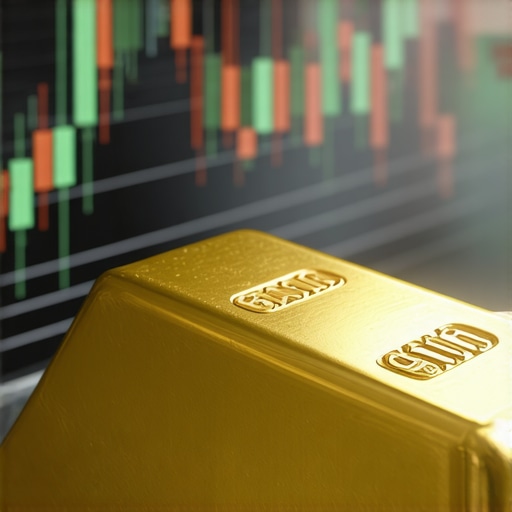Introduction to Gold Demand Trends and Their Impact on Prices
Gold has long been a symbol of wealth and a cornerstone of investment portfolios. In recent years, analyzing gold demand trends has become essential for investors aiming to understand what drives prices. The dynamics of gold prices are influenced by various factors, including economic conditions, geopolitical stability, and changes in demand from key markets. This article delves into the critical elements that affect gold demand and pricing, giving investors the insight they need to make informed decisions.
The Role of Economic Indicators in Gold Demand
Economic indicators play a significant role in shaping gold demand. When inflation rates rise, many investors turn to gold as a hedge against currency devaluation. This behavior is particularly evident in uncertain economic climates, where gold is viewed as a safe haven asset. Additionally, central banks often increase their gold reserves during economic downturns, further driving demand.
Geopolitical Factors and Their Influence on Gold Prices
Geopolitical tensions can also significantly impact gold prices. Conflicts, trade wars, and political instability create uncertainty, prompting investors to seek refuge in gold. For example, during times of heightened geopolitical risk, the demand for gold typically surges, leading to price increases. Understanding these geopolitical factors is crucial for predicting potential fluctuations in gold prices.
Shifts in Consumer Demand: The Impact of Jewelry and Industrial Uses
Consumer demand for gold extends beyond investment; it also includes jewelry and industrial applications. Countries like India and China are major consumers of gold jewelry, and fluctuations in consumer spending can directly impact prices. Additionally, the use of gold in electronics and technology is growing, adding another layer of demand that investors must consider. Monitoring these trends helps investors gauge the overall health of the gold market.
Investment Trends: ETFs and Gold Mining Stocks
Investment vehicles such as gold exchange-traded funds (ETFs) have revolutionized how investors access gold. As more investors turn to these instruments, understanding their influence on gold demand is essential. Furthermore, gold mining stocks provide another avenue for investing in gold. Analyzing the performance of these stocks can offer insights into the broader gold market and potential price movements.
Conclusion: Staying Informed on Gold Demand Trends
In conclusion, analyzing gold demand trends involves considering a multitude of factors, from economic indicators to geopolitical events and consumer behaviors. For those looking to invest in gold, staying informed about these trends is crucial for making strategic decisions. Whether you’re a seasoned investor or new to the gold market, understanding what drives demand will help you navigate the complexities of gold pricing and optimize your investment portfolio. For further insights, check out our comprehensive guides on gold price forecasts and understanding gold demand trends.
Investment Strategies: How to Leverage Gold Demand Insights
For investors, understanding gold demand trends is essential for formulating effective investment strategies. By analyzing market data and consumer preferences, investors can identify opportunities to maximize their returns. One effective strategy is to invest in gold ETFs or mutual funds, which allow for diversified exposure to gold without the need for physical ownership. These investment vehicles can provide a buffer against market volatility, especially in uncertain economic times.
The Importance of Timing in Gold Investments
Timing plays a crucial role in the success of gold investments. Investors should monitor demand trends closely, as they often correlate with price fluctuations. For instance, during periods of increased consumer demand—such as wedding seasons in India—gold prices may rise. Similarly, geopolitical tensions can trigger spikes in demand, leading to a profitable investment opportunity. Implementing a strategy that considers these timing factors can significantly enhance an investor’s returns. To learn more about timing your investments, explore our detailed article on gold price forecasts.
Evaluating Gold Investment Risks and Opportunities
Investing in gold is not without its risks. Market fluctuations, changes in demand, and economic instability can all impact gold prices. Investors must be aware of these risks and develop strategies to mitigate them. Conducting thorough research on gold mining stocks or gold-backed securities can help investors identify potential risks associated with their portfolios. For a deeper understanding of how to navigate these risks, check our guide on understanding the risks of gold investments.
Monitoring Global Economic Indicators
Global economic indicators are vital for assessing the health of the gold market. Inflation rates, interest rates, and currency depreciation all influence gold demand. For instance, when inflation rises, the value of fiat currencies tends to decline, pushing investors towards gold as a hedge. Keeping an eye on these indicators will empower investors to make informed decisions about when to buy or sell gold assets. Regularly reviewing reports from central banks can also provide insights into future demand trends.
Consumer Behavior: The Shift Towards Sustainable Gold
Another emerging trend in gold demand is the shift towards sustainability. Consumers are increasingly interested in ethically sourced gold and environmentally friendly mining practices. This demand for sustainable gold is affecting market dynamics, with investors needing to adapt to changing consumer preferences. Understanding these shifts can present new investment opportunities, especially for those looking to align their portfolios with sustainable practices.
The Role of Technology in Gold Demand
Technology is also transforming the gold market. Innovations in mining, trading, and investment platforms are making gold more accessible to a broader audience. For example, digital gold trading platforms allow investors to buy and sell gold easily, further increasing demand. Additionally, advancements in gold recycling technologies are helping meet the growing demand without the need for new mining. Keeping abreast of technological developments can provide investors with an edge in the market.
Conclusion: Staying Ahead of Gold Demand Trends
In conclusion, understanding gold demand trends is vital for any investor looking to navigate the complexities of the gold market. By considering economic indicators, geopolitical factors, consumer behavior, and technological advancements, investors can make more informed decisions. To enhance your investment strategy, explore our articles on gold vs. stocks and why investing in gold is essential for maintaining a well-rounded investment portfolio.
Understanding Geopolitical Influences on Gold Demand
Geopolitical events are critical drivers of gold demand, often leading to price volatility. Investors should pay attention to global tensions, trade disputes, and political instability, as these factors can elevate gold’s status as a safe haven asset. For instance, during economic turmoil or conflicts, investors flock to gold to preserve their wealth. Keeping informed about international relations and their potential impact on gold prices can significantly enhance your investment strategy. To explore more about how global events impact gold prices, visit our article on global events and gold prices.
Gold Demand Trends in Emerging Markets
Emerging markets, particularly in Asia, are experiencing a surge in gold demand. Countries like India and China have a long-standing tradition of gold investment, primarily for cultural and economic reasons. Understanding these regional trends can offer investors insights into potential price movements. For example, the festival seasons in these countries often see spikes in gold purchasing, influencing global demand. By analyzing such trends, investors can position themselves strategically to benefit from anticipated price increases during peak demand periods.
Investment Strategies for Gold in a Volatile Market
In a volatile market, having a robust investment strategy is crucial. Diversifying your gold portfolio can help mitigate risks associated with market fluctuations. Consider allocating investments across various gold assets, including physical gold, gold ETFs, and mining stocks. Each of these options presents unique advantages and risks. For more detailed strategies on how to maximize your returns, check our post on gold investment strategies.
Utilizing Technical Analysis for Gold Investments
Technical analysis is a valuable tool for investors looking to make informed decisions about gold trading. By studying price patterns and trading volumes, investors can identify potential entry and exit points. This analytical approach can be especially beneficial in a fluctuating market, allowing investors to capitalize on short-term price movements. For those new to technical analysis, our comprehensive guide on gold trading techniques can provide essential insights to enhance your trading skills.
Staying Informed: The Role of Research in Gold Investment
Regularly conducting research on market trends, news, and economic data is vital for successful gold investing. Investors should utilize various resources, including financial news outlets, investment reports, and market analysis from experts. Staying informed will help you understand the underlying factors driving gold demand and prices, enabling more precise investment decisions. To keep abreast of the latest insights, explore our in-depth articles on gold market analysis.
Conclusion: Adapting to Evolving Gold Demand Trends
In conclusion, navigating gold demand trends requires a multifaceted approach that considers geopolitical influences, emerging market behaviors, and effective investment strategies. By staying informed and adapting to market changes, investors can position themselves to benefit from the opportunities that arise in the gold market. To enhance your investment knowledge further, check out our resources on understanding gold demand trends and the importance of gold in your portfolio.
Understanding The Impact of Inflation on Gold Prices
Inflation plays a significant role in shaping gold prices. As the cost of living rises, the purchasing power of currency decreases, often leading investors to flock to gold as a hedge against inflation. During inflationary periods, gold has historically maintained its value, making it an attractive option for those looking to preserve their wealth. Investors should monitor inflation rates and economic forecasts to make informed decisions about when to buy or sell gold. For insights into how inflation specifically affects gold pricing, check our detailed post on inflation and gold prices.
Global Economic Factors Influencing Gold Demand
Various global economic factors influence gold demand, including currency fluctuations, interest rates, and economic growth rates. A strong U.S. dollar can lead to lower gold prices, while weak economic indicators may push investors towards gold as a safe haven. Understanding the relationship between these economic factors and gold pricing can provide investors with an edge. Keeping an eye on central bank policies and international trade agreements can also yield insights into potential price movements. For a closer look at economic factors that shape gold markets, read our article on gold market analysis.
Investing in Gold Mining Stocks: Opportunities and Risks
Investing in gold mining stocks can present a lucrative opportunity for investors looking to capitalize on the gold market. Mining companies tend to benefit from rising gold prices, but they also come with inherent risks such as operational challenges and fluctuating production costs. It’s essential for investors to evaluate the financial health of mining companies and understand the factors affecting their operations, including labor issues and geopolitical risks. For a comprehensive guide on investing in gold mining stocks, visit our post on gold mining investments.
Utilizing Gold ETFs for Diversified Exposure
Gold Exchange-Traded Funds (ETFs) offer a convenient way for investors to gain exposure to gold without the complexities of physical storage. These funds track the price of gold and can be easily bought or sold on stock exchanges, providing liquidity and flexibility. When considering gold ETFs, it’s important to research the fund’s management fees, liquidity, and the underlying assets it holds. For a deep dive into the benefits of gold ETFs, check out our article on gold ETFs vs. mutual funds.
Conclusion: A Holistic Approach to Gold Investment
In summary, investing in gold requires a nuanced understanding of various factors including inflation, economic trends, and investment vehicles such as mining stocks and ETFs. By staying informed and adaptable, investors can navigate the complexities of the gold market effectively. Whether you are considering gold as an inflation hedge or diversifying your portfolio, educating yourself on investment strategies is essential. Explore our resources on the role of gold in today’s economy and gold investment tips for beginners to enhance your investment success.
Frequently Asked Questions About Gold Investment
What factors influence gold prices?
Gold prices are primarily influenced by inflation, interest rates, currency strength, and geopolitical uncertainty. As these factors fluctuate, they can lead to varying levels of demand for gold, affecting its market price.
Is investing in gold a safe option?
While gold is often viewed as a safe haven asset, it is not without risks. Market volatility, changes in economic conditions, and shifts in investor sentiment can impact gold prices. It’s essential to conduct thorough research and consider your risk tolerance before investing.
How can I buy physical gold?
You can purchase physical gold in the form of coins, bars, or jewelry from reputable dealers, online retailers, or auctions. Ensure you buy from established sources to avoid counterfeit products.
What are the benefits of gold ETFs?
Gold ETFs provide a convenient way to invest in gold without the need for physical storage. They offer liquidity, diversification, and lower costs compared to purchasing physical gold. Investors can easily buy or sell shares on stock exchanges, making them a flexible investment option.
How do gold mining stocks perform compared to physical gold?
Gold mining stocks can provide leveraged exposure to gold prices, meaning they may rise faster than gold itself in bullish markets. However, they also carry operational risks and can be influenced by factors beyond gold prices, such as management decisions and production costs.
What is the best way to hedge against inflation with gold?
Investing in gold during inflationary periods can help preserve wealth, as gold often retains its value when currency purchasing power declines. You can consider a mix of physical gold, gold ETFs, and mining stocks to create a diversified inflation hedge.
How often should I review my gold investments?
Regularly reviewing your gold investments is important to ensure they align with your financial goals and the current market conditions. Aim to assess your portfolio at least annually or when significant economic events occur.
Can I invest in gold through retirement accounts?
Yes, certain retirement accounts, such as Self-Directed IRAs, allow you to invest in gold and other precious metals. Be sure to follow IRS regulations regarding the types of gold you can hold within these accounts.
What are the tax implications of selling gold?
When selling gold, you may be subject to capital gains tax depending on how long you held the asset and your profits. It’s advisable to consult with a tax professional to understand the specific tax implications in your situation.
Where can I find reliable information about gold investment?
Reliable information can be found on financial news websites, investment blogs, and government resources. Trusted sources include the World Gold Council, U.S. Geological Survey, and reputable financial institutions.
Authority Resources for Gold Investment Insights
For those looking to deepen their understanding of gold investments, consider the following authoritative resources:
- World Gold Council – Offers insights on gold trends, market dynamics, and investment strategies.
- Investopedia – Provides educational articles and guides on gold investment fundamentals.
- Kitco – A leading platform for real-time gold prices, news, and analysis.
- Reuters Commodities – Offers up-to-date news and analysis on commodity markets, including gold.
- CNBC Commodities – Provides market news and insights on commodity trading, including gold.
Conclusion: Navigating Your Gold Investment Journey
In conclusion, investing in gold offers a strategic approach to wealth preservation and portfolio diversification. By understanding the various influences on gold prices, utilizing different investment vehicles, and staying informed through reliable resources, you can maximize your gold investment potential. Whether you’re hedging against inflation or exploring gold mining stocks, informed decision-making is key to success in the gold market.











This article does a great job breaking down the complex factors that influence gold prices, especially highlighting how intertwined economic indicators and geopolitical issues are with gold demand. From my experience watching markets during inflation surges, gold really does act as a reliable hedge, but timing is everything. For example, the spike in demand during the wedding season in India is fascinating because it demonstrates how cultural factors can also sway global gold prices, something investors might overlook. Equally intriguing is the rise of gold ETFs and how they’ve transformed accessibility for retail investors like myself who may not want to handle physical gold. However, I often wonder how much the rise in digital gold trading platforms will further disrupt traditional gold investment approaches. Are we moving towards a future where technological innovation may decouple gold demand from some of these historical drivers? I’d love to hear how others balance these evolving trends with the more traditional safe haven behaviors of gold investing.
This article provides a comprehensive overview of the many factors that influence gold demand, from economic indicators to geopolitical tensions. I find it particularly interesting how cultural and regional behaviors, like the Indian wedding season, can impact global demand so significantly. It’s a clear reminder that gold isn’t just an abstract financial instrument; it’s deeply connected to societal practices and economic trends. Moreover, the rise of digital gold trading platforms is transforming accessibility, making it easier for individual investors to participate without holding physical gold. I’ve been contemplating whether this technological shift might weaken traditional drivers like geopolitical risks or inflation concerns, as demand becomes more electronic and perhaps more speculative. How do other investors here perceive this evolution? Do you see digital gold as a supplement to traditional investment strategies, or as a replacement in certain contexts?”